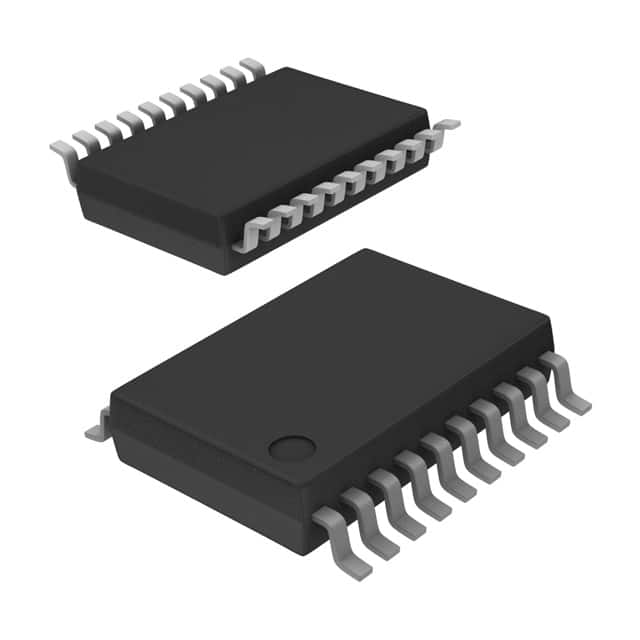Xem thông số kỹ thuật để biết chi tiết sản phẩm.

SN74LV374ATDBR
Product Overview
- Category: Integrated Circuit (IC)
- Use: Flip-Flop
- Characteristics: Low-voltage, Octal D-type transparent latch with 3-state outputs
- Package: TSSOP (Thin Shrink Small Outline Package)
- Essence: The SN74LV374ATDBR is a high-performance, low-voltage octal D-type transparent latch designed for general-purpose storage applications in digital systems.
- Packaging/Quantity: Tape and Reel, 2500 pieces per reel
Specifications
- Supply Voltage Range: 1.65V to 5.5V
- High-Level Input Voltage: 2V (minimum), VCC (maximum)
- Low-Level Input Voltage: GND (minimum), 0.8V (maximum)
- High-Level Output Voltage: VCC - 0.6V (minimum), VCC (maximum)
- Low-Level Output Voltage: GND (minimum), 0.1V (maximum)
- Operating Temperature Range: -40°C to +85°C
Detailed Pin Configuration
The SN74LV374ATDBR has a total of 20 pins. The pin configuration is as follows:
- OE (Output Enable) - Output Enable Input
- CP (Clock Pulse) - Clock Pulse Input
- D0 (Data Input) - Data Input for Flip-Flop 0
- D1 (Data Input) - Data Input for Flip-Flop 1
- D2 (Data Input) - Data Input for Flip-Flop 2
- D3 (Data Input) - Data Input for Flip-Flop 3
- D4 (Data Input) - Data Input for Flip-Flop 4
- D5 (Data Input) - Data Input for Flip-Flop 5
- GND (Ground) - Ground
- Q0 (Output) - Output for Flip-Flop 0
- Q1 (Output) - Output for Flip-Flop 1
- Q2 (Output) - Output for Flip-Flop 2
- Q3 (Output) - Output for Flip-Flop 3
- Q4 (Output) - Output for Flip-Flop 4
- Q5 (Output) - Output for Flip-Flop 5
- VCC (Power Supply) - Power Supply Voltage
- D6 (Data Input) - Data Input for Flip-Flop 6
- D7 (Data Input) - Data Input for Flip-Flop 7
- GND (Ground) - Ground
- Q6 (Output) - Output for Flip-Flop 6
Functional Features
The SN74LV374ATDBR offers the following functional features:
- Octal D-type transparent latch with 3-state outputs
- Low-voltage operation, suitable for various digital systems
- Output enable control for easy data storage and retrieval
- Clock pulse input for synchronized data transfer
- High-speed operation for efficient data processing
- 3-state outputs for bus-oriented applications
Advantages and Disadvantages
Advantages: - Low-voltage operation allows compatibility with a wide range of digital systems - High-performance design ensures efficient data storage and retrieval - 3-state outputs enable flexible bus-oriented applications - Compact TSSOP package saves board space
Disadvantages: - Limited to octal (8-bit) data storage applications - Not suitable for high-voltage environments
Working Principles
The SN74LV374ATDBR operates as an octal D-type transparent latch. When the output enable (OE) signal is active, the data inputs (D0-D7) are latched and stored in the flip-flops. The clock pulse (CP) input synchronizes the transfer of data from the inputs to the outputs. When the OE signal is inactive, the latch holds the previously stored data. The 3-state outputs allow multiple devices to share a common bus without interference.
Detailed Application Field Plans
The SN74LV374ATDBR can be used in various digital systems that require efficient data storage and retrieval. Some potential application fields include:
- Microcontrollers: Used for storing and transferring data between different peripherals and memory units.
- Communication Systems: Enables data buffering and synchronization in communication protocols such as UART, SPI, and I2C.
- Data Acquisition Systems: Facilitates the capture and storage of analog signals for further processing.
- Industrial Automation: Provides reliable data storage and transfer in control systems and PLCs.
- Automotive Electronics: Supports data handling in automotive applications like engine management systems and infotainment systems.
Detailed and Complete Alternative Models
- SN74LV374A: Similar octal D-type transparent latch with 3-state outputs, but operates
Liệt kê 10 câu hỏi và câu trả lời thường gặp liên quan đến ứng dụng SN74LV374ATDBR trong giải pháp kỹ thuật
Sure! Here are 10 common questions and answers related to the application of SN74LV374ATDBR:
Question: What is the SN74LV374ATDBR?
- Answer: The SN74LV374ATDBR is a flip-flop integrated circuit (IC) that can be used for various digital logic applications.Question: What is the operating voltage range of SN74LV374ATDBR?
- Answer: The operating voltage range of SN74LV374ATDBR is typically between 2V and 5.5V.Question: How many flip-flops are there in the SN74LV374ATDBR?
- Answer: The SN74LV374ATDBR contains 8 D-type flip-flops.Question: What is the maximum clock frequency supported by SN74LV374ATDBR?
- Answer: The maximum clock frequency supported by SN74LV374ATDBR is typically around 125 MHz.Question: Can I use SN74LV374ATDBR for level shifting?
- Answer: Yes, SN74LV374ATDBR can be used for level shifting as it supports both 3.3V and 5V logic levels.Question: Does SN74LV374ATDBR have any output enable feature?
- Answer: Yes, SN74LV374ATDBR has an active-low output enable (OE) pin that can be used to disable the outputs.Question: What is the typical propagation delay of SN74LV374ATDBR?
- Answer: The typical propagation delay of SN74LV374ATDBR is around 6 ns.Question: Can I cascade multiple SN74LV374ATDBR ICs together?
- Answer: Yes, you can cascade multiple SN74LV374ATDBR ICs together to increase the number of flip-flops.Question: Is SN74LV374ATDBR suitable for high-speed applications?
- Answer: Yes, SN74LV374ATDBR is designed for high-speed operation and can be used in various high-speed applications.Question: What is the package type of SN74LV374ATDBR?
- Answer: SN74LV374ATDBR comes in a TSSOP-20 package, which is a small surface-mount package with 20 pins.
Please note that the answers provided here are general and may vary depending on specific datasheet specifications and application requirements.

